10 Advantages & Disadvantages Of Social Media For Business
Have you been thinking about the benefits of social media for businesses?
You’re not the only one. Many entrepreneurs know the importance of having a social media presence. However, they always have to weigh it against its disadvantages — and yes, there are disadvantages to it.
In today’s post, you’re going to learn the advantages and disadvantages of using social media to grow your business. That way, you can figure out for yourself whether this is the right move for your business or not.
Advantages of social media for business
Not only should businesses have a website but they should also have a presence on social networking sites as well. The advantages go beyond having a place to put social media posts. With the right social media marketing strategy, you can expand your brand’s reach and get more sales.
Here are some reasons you’d want to invest in social media networks.
Increases brand awareness
One of the benefits of social media for businesses is having brand awareness. A good SEO strategy can only cover search engines. If you want your presence felt where people are, you’ll have to jump into social media marketing.
Business owners and marketers are not oblivious to all social media benefits. They have even incorporated social media into their digital marketing efforts for years now.
93.7% of businesses said they use Facebook to promote their brand according to a 2019 Buffer research. 84.4% said they are on Twitter, 80.9% focused on Instagram, and 70% found themselves on LinkedIn.
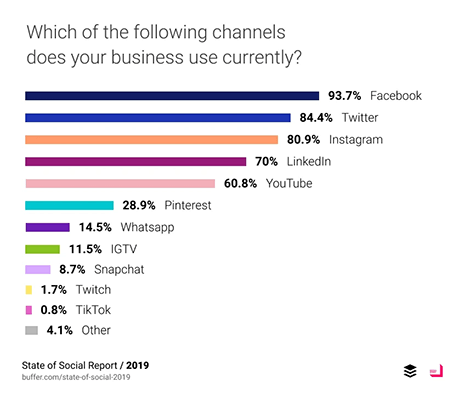
Note that these stats were collected just before TikTok took over the online world. Today, TikTok is the biggest platform for creators and advertisers alike considering it’s the most downloaded app worldwide in 2021 at 656 million.
There are different ways you can get the attention of social media users. The simplest way would be to create engaging content. What can be considered “engaging” will depend on what platform you’re in and who’s your target audience.
For example, Wendy’s managed to create an online persona that its potential customers have come to adore over time. While their approach might not work for every brand, it only shows the potential that comes with social media.
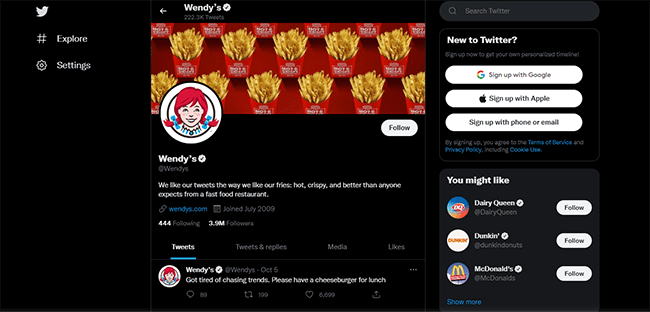
You can also use influencers to showcase your products or services. Some use social posts to give out discounts or announce sales and promotions.
Improves brand reputation
Brand reputation is all about how users talk, feel, and think about a company. If customers like or dislike your products and services, you can bet that they’re talking about it online whether you have a social media presence or not.
By being present on social media platforms, you’re giving yourself a chance to control part of the narrative. Should you find an unfavorable conversation about your brand, you can jump right into it and make clarifications or make an apology.
To get a good brand reputation, you need to stay consistent. Consistency does not only refer to how frequently you post or comment. It’s also about delivering the same message. If that message manages to resonate with your target audience, you can expect to gain more followers.
Reputation management also helps when users research your brand on social media. GWI notes in its research that 54% of social browsers use social media to research products.

In a month’s time, 37% of survey respondents said they visited a brand’s social media page with 36% saying they liked or followed a brand based on what they saw.
For those reasons, you want to make sure that you have a great reputation on social media platforms. You don’t want to leave your online reputation in the hands of other users. You want to be in control of the information that potential customers find on social media.
Builds an online community
Why should a business build an online community?
A CMX study asked brands that same question. And according to 86% of respondents, it’s because branded online communities will positively impact core business operations.
More specifically, online communities will allow businesses to get people to trust them more, provide better customer service, and gain insight that can help them improve their operations.
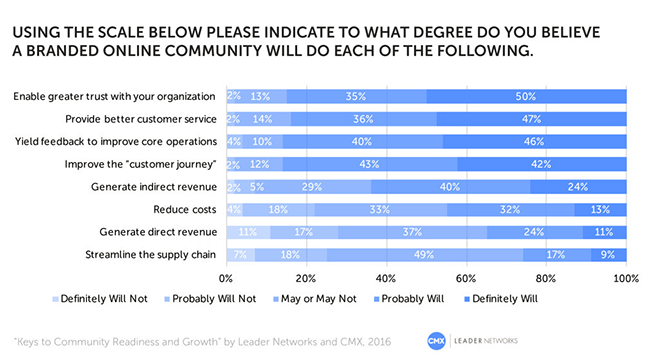
You see, it’s not just about giving your brand’s fans a space where they can interact with one another. Online communities can help you collect data that you can use to improve business operations.
If people go to your social media pages to complain about the checkout process being way too complicated than it has to be, you’ll know that there’s a problem that needs to be addressed. Your social media followers can keep your business in check and alert you if there’s been a huge oversight on your end.
You can also use your online community to keep followers updated about projects you’re working on.
One of the best benefits of social media communities is getting feedback right away. You’ll know what people feel about a particular business move as soon as you let them know about it. So you can use your community to calculate your company’s next moves.
For example, a SaaS company might think about pulling a specific product feature to replace it with another. A social media post announcing the move will let them know if this is something their community will be okay with. And if the post draws negative feedback, the company can use that data to think about what they should do next.
Reduces marketing cost
Having a social media marketing strategy is great for businesses that want a more cost-efficient way of delivering its message. Most (if not all) social media platforms are free to use, even for businesses. In fact, social media sites have programs in place to encourage companies to sign up for a business account.
And how does social media marketing compare to other digital marketing channels? Quite great, actually. As of 2021, it’s the second most-effective channel in driving sales according to SMBs worldwide at 18.9%.
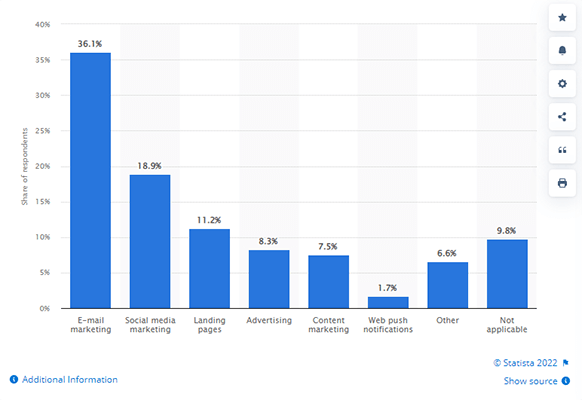
While you don’t have to spend money on social media advertising and rely on organic posting instead, you will have to invest time and resources to create content. So there is still some marketing cost attributed to it.
Social media for business is not 100% free. But it still saves you more money than other digital marketing strategies. This is especially true if you’re using social media for lead generation.
Yes, you can get your followers’ personal details by incentivizing them to give them to you. For example, there are social media contests where users provide their email addresses for a chance to win a special prize. You can then add these emails to your list of leads.
Unlike other methods of collecting names and emails for lead generation, social media won’t cost as much.
Increases website traffic
Social media will drive traffic to your website — but only if you use it correctly.
There’s more than one way to redirect traffic to your domain. The simplest would be to link landing pages in your posts. However, editing your social media profile to include links to your homepage or product pages will also help.
Increasing your site traffic means having more eyes on your products. It’s a great way to make people understand what you have to offer.
You can also use social media to redirect followers to other sites too. For instance, linking to positive reviews of your brand will instill confidence in your company. And if you have a YouTube channel that you’d like to promote, you can link to a couple of episodes every now and then.
With that said, what type of organic content will help you engage your users and increase your website traffic?
According to HubSpot, funny content has the best return on investment at 27%. Interactive content comes second at 17%. 15% said that valuable content that reflects the brand’s value produces good ROI. Relatable content is also popular at 11%. 10% believe that educational or informational content is the best.
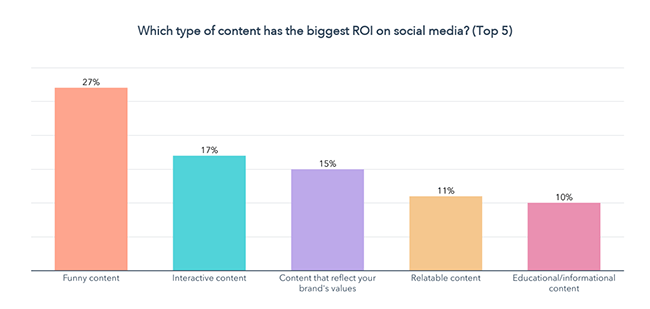
So if you’re looking to drive up your website traffic, posting funny content will give you the best results.
Promotes brand loyalty
Businesses like having social media profiles because it allows them to gain new followers. But marketers know that there’s more to social media than that. They know that one of the best benefits of social media is that it allows them to retain customers.
Retaining customers can get pretty expensive. But that cost is reduced when you use social media to connect with your followers. By communicating with customers regularly, you build a special relationship with them. You can use jokes, photos, or videos to make your brand relatable.
So what are some of the best practices when it comes to building brand loyalty?
First, you’ll have to respond to comments that are posted on your social channels. That means replying to customer inquiries, concerns, and suggestions. You want to make each follower feel like they’re being heard.
Replying is just as important when you receive positive feedback about your business. Not only are you acknowledging your customer’s glowing feedback, but you’re showing new followers and potential customers that your products are worth buying. And it gives current customers another reason to continue supporting your brand.
According to a Microsoft survey, 74% of millennials said that social media responsiveness improves their perception of a brand. The same survey states that 96% of respondents said that customer service plays a role in their choice of (and loyalty) to a brand.
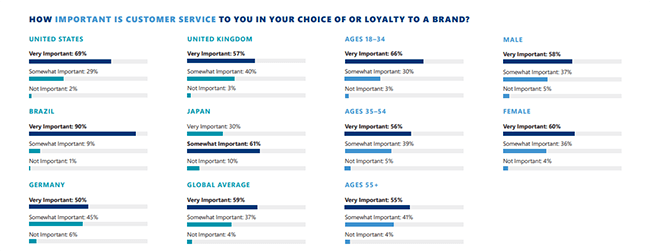
Sharing user-generated content is a great idea. For example: If you own a pie company, sharing photos of your customers enjoying your products will make them want to come back for more. It will show that you care about their satisfaction.
Posting content about valuable insights you’ve learned or roadmaps you’re taking will show your followers that you’re committed to improving your products and services. And when followers realize how much you care about them, it will translate to their continued support.
Disadvantages of social media for business
Every business owner needs to understand that there are risks to running social media profiles. These are just a few of the things that you’ll need to be mindful of.
Takes up resources
Yes, running social media accounts is free (unless you decide to run ads, of course). You won’t have to pay money to create posts, upload videos, or reply to comments.
But:
Maintaining social media accounts will take time and manpower. And the harsh reality is that not every business has the hours or the people they need to do it efficiently. You don’t want one person running a social media campaign on top of email marketing. That’s just brutal.
The ideal solution would be to have a dedicated team handling all things social. And you’d want to hire a battle-tested social media manager or—at the very least—consult with someone who knows how to run social campaigns.
You might also have to invest in third-party tools that will make social media management easier for your employees. For example, using a social media scheduler like SocialBee will allow your team to automate part of the process.
It’s also not that uncommon to purchase or subscribe to collaboration and monitoring tools that help teams make smarter business decisions.
For example, social media listening tools like Brand24 can be useful for this. They can also help you to uncover reputation issues before they get blown out of proportion.
Increases risks
You gain valuable information when you use social media. The customer feedback alone gives you enough information to improve your business based on what your customers need.
But there’s a catch:
All comments posted by your followers will be seen by everyone — the good and the bad.
This isn’t a problem if all user posts and comments are positive. But they rarely are. You’ll definitely get messages from unsatisfied customers. And they might end up saying things that could turn new customers off.
You’d think turning off comments would resolve all of that. However, that’s usually a red flag for social media users. Disabling new posts and comments are a sign that a business has something to hide.
So what do you do?
Here are a couple of ways you can minimize your risks when using social media.
- Take some time out — If you read something that you don’t agree with, don’t reply while you’re angry. Otherwise, you’ll end up saying something that’s only going to make the situation worse. Take a breather. Only reply after you’ve calmed down.
- Shut down negative comments — Once a user posts something negative about your products or brand, try to address the issues right away. Find out what’s upsetting the users and address their problems head on. If you don’t, there’s a chance that other users will also comment on similar experiences.
- Stop oversharing — You don’t have to create organic posts about everything you’ve got going on. Sometimes it’s better to be quiet about certain aspects of the business. Making premature announcements can be a cause of trouble, especially if you don’t end up pushing through. On a related note, make it a point that you don’t share your personal information.
- Monitor who has access to your accounts — If someone on your team accidentally posts something they shouldn’t have, you’ll want to know which of your employees did it so you could take action right away. Limit the access to your social accounts to a few people. And make it a habit to change the password whenever someone leaves their position.
Highlights mistakes
Social media users can be unforgiving when they see errors in posts. While you can get away with a typographical error here and there, expect to be on the receiving end of fierce criticism if you post something more controversial and divisive.
If you’re not versed in public relations, you could find yourself in a situation that’s bound to spiral out of control.
Is it that easy to make mistakes on social media? Yes, it is. Even big brands find themselves in hot water now and then.
Remember when DiGiorno tried to promote its pizza using a trending hashtag about domestic abuse?

The backlash had been tremendous but the brand handled itself well. It issued apologies to people who were offended by the tweet. And eventually, people moved on from the controversy.
But what happened to DiGiorno can happen to any brand.
Is it possible to avoid mistakes like this?
Yes. Here are a couple of things you could do:
- Review all posts — It’s important that you have at least one person review all posts before they’re scheduled for publishing. This person should make sure that all content published on social media is not offensive.
- Stay consistent — You don’t want to send mixed messages. So stay consistent in your messaging. People will call you out if you contradict yourself.
- Avoid sensitive subjects — Avoid sensitive issues if you can. Don’t talk about politics and other divisive topics especially if they have nothing to do with your brand’s messaging. If you decide to take a stance on an issue, just make sure that you do your research in case you need to defend yourself from detractors.
- Train your team — You should train all members of your social media team so they know what they can and cannot do. Having a set of rules and guidelines will help. Have an onboarding process for new members.
- Have a dedicated customer service representative — Complaints about your products and services should be answered by a customer service representative and not by your social media people. A customer rep would be in a better position to address specific concerns like shipping delays and refunds.
Confuses you with different metrics
One of the downsides of using social media is that it tends to confuse you because of all the metrics you have to keep track of.
There’s no one way to measure the success of a social media campaign. One business might use follower count as their core metric while others might put more weight on likes, shares, or comments.
Needless to say, it can get confusing as to which metric online marketers and business owners should pay attention to.
What are some of the social media metrics you have to pay attention to?
- Engagement rate — These are your likes, shares, retweets, and other metrics that show user engagement.
- Post-engagement rate — This is the number of engagements divided by impressions or reach.
- Mentions — Measures how much people tag you in posts organically. That means followers tag you in posts just because they want to and not because you prompted them to do so.
- Reach — The number of people who have seen your social posts.
- Impressions — The number of times people saw your content. To clarify, if one person saw your post twice then it has a reach value of 1 and an impression value of 2.
- Growth rate — The number of followers your social media account gained in a specified period.
- Video views — This refers to the number of times people watched your content. Every social site computes “views” differently though. Just something to keep in mind.
- Video completion — This is how often people would watch your video all the way to the end.
Should your business have a social media presence?
You’ve seen all the key benefits of social media for businesses. And you now know that there are disadvantages too.
So what’s the verdict? Should businesses have social media pages?
Yes, they should.
Every online marketer would recommend having a Facebook, Twitter, Tiktok, or Instagram account. In fact, you should be on as many social media sites that fit your business. For instance, not every business needs to have a Pinterest account.
There are disadvantages to having social media accounts for businesses, sure. But there are ways you can work around that. This list wasn’t published to discourage you. What it’s trying to do is prepare you for what could happen. That way, you’ll know how to avoid the issues associated with social media for business.
Used the right way, social media can help you build relationships with old and new customers. It’s definitely worth investing in.
Not convinced? Just check out these social media stats.
